Rabia Aslam, Naveed E. Seher
Department of Library & Information Science, University of Karachi, Karachi, Sindh, Pakistan
Correspondence to: Rabia Aslam, Department of Library & Information Science, University of Karachi, Karachi, Sindh, Pakistan.
| Email: |  |
Copyright © 2018 Scientific & Academic Publishing. All Rights Reserved.
This work is licensed under the Creative Commons Attribution International License (CC BY).
http://creativecommons.org/licenses/by/4.0/

Abstract
Users are the significant component of any library. The identification and fulfillment of their needs and to meet their satisfaction are the objectives any library. Since the role of public libraries in rendering such goals is difficult to deny. This paper mainly focuses on the services provided by Liaquat Memorial library and satisfaction level of these services from user’s perspective. The study focuses to help the librarians, information managers and the management in identifying the potential users of library as well as their information needs. It also help in making it clear how to perform relevant duties and serving the best possible way to satisfy their ultimate users attaining their satisfaction level and by diminishing the unsatisfactory elements of library. The study thus designed a Descriptive Survey and applied random Sampling Technique over 300 users of library. The questionnaire was used as a tool to collect data, where 250 questionnaires were received from respondents. Descriptive statistical methods were used to analyze the data where tables with Frequencies and Percentages are represented along with. It was discovered by the study that the library is playing vital role at some extend but many areas need to be revised to meet the expectation and intellectual needs of society.
Keywords:
Public library, Library services, Information needs, User’s intellectual satisfaction, Information, Public library users
Cite this paper: Rabia Aslam, Naveed E. Seher, User Satisfaction Survey of Public Library: A Study of Liaquat Memorial Library, Karachi, Pakistan, International Journal of Library Science, Vol. 7 No. 1, 2018, pp. 8-14. doi: 10.5923/j.library.20180701.02.
1. Introduction
A public library is a library that is made to serve the public irrespective of its cast, gender and religion, to serve them intellectually and educate informally. Public library in every society carries its great importance. It acknowledges the society from its preserved intellectual heritage. Usually such types of libraries are established by public funds at Governmental level to fulfill the educational as well as other literary needs of a society. Public libraries are such democratic institution that serves the society regardless of any benefit. Thus, these are considered as those serving institutions that work by the public and for the development of public.This research study is based on Liaquat Memorial library, a public library at a common locality of Karachi, focusing on the level of satisfaction of its users. “It is well known that public libraries are playing vital role in any society, however little research is reported about user satisfaction level with services and resources provided by Public libraries in Pakistan” [1]. This study will reveal the current status of library’s services and facilities despite the critical conditions it faces. It will be helpful in analysing the present status of user’s satisfaction from the existing condition of library. It will answer the queries that how in such crucial financial conditions the library manages to work as beneficial for its patrons.
2. Public Library
Prytherch discusses that partially or completely a public library runs from the funds of public and is made to serve the public irrespective of the class, age or community. So that individual of each community is capable of acquiring the required source of knowledge, without any restriction. [2] This contrast the concept of IFLA/UNESCO (2001) manifesto as “the public library, the local gateway to knowledge, provides a basic condition for lifelong learning, independent decision making and cultural development of the individual and social groups” [3]. Manifesto declares UNESCO’s belief in the public library as a breathing force for education, culture and information, and as an indispensable agent for the nurturing of peace and spiritual well being through the minds of men and women”. [4]. According to Newke [5] “Libraries are repositories of knowledge or storehouses of written records of civilization in various forms of the information package and play informational, recreational, research, cultural and educational roles”.These public libraries aim to satisfy their users intellectually through their resources, services and facilities. Akinola [6] noted that “libraries embody a principle of rights of access to information and acquisition of knowledge by all categories of individual in a society”. As these libraries are nonprofit organizations and funded by local Government, the conditions of state also affects the services of its public libraries. Pakistan being an independent state is still in a process of development. Hence, due to the financial constraints that it faces makes it hard to facilitate the libraries with proper funds. Libraries, among which Liaquat Memorial Library is one the famous and initially recognized as National library of Pakistan, situated in Karachi, also get highly affected by such financial crisis of the state. [7] Ang. gave “six approaches to the role of public libraries in “postmodern” society: 1. The public library emerges as the community’s market place where people meet and discuss things. It presents a space reserved for free debate and open thinking, a public floor for dialog, education and experiences. There are no limits to communication between visitors and to the acquiring of knowledge worldwide and multi-media. The public library is a place of lifelong learning, an open university. It will satisfy the needs of tomorrow’s society and offer everything to almost everybody.2. The public library may act as the community’s information switchboard. At the library, the customer can become acquainted with data on their community, communicate with leading administrators, create own information, and offer to help producing community information or with other assignments. This way, the library becomes an open agency for information and news. Thus, the public library will slowly take on the features of a multimedia workshop.3. Information services free of charge and the inter-library network are almost unique as an infrastructure. These networks guarantee the libraries future and ought to be maintained and developed in view of the competitors. In the world of the future, it will turn out to be of particular importance to librarians to help one another in systematizing useful information from the information highway.4. Services at a distance will be possible, i.e. the public library is delivering its services to our homes via digital technology. This include all of the internet, CD-ROMs, utility programs, the library catalog, etc. in this field, vast vistas open up to the public library. 5. The public library needs to open up to the world outside in order to find useful partners for its development and to co-operate with them in the market. In the first place, these will include trade and industry, especially the IT sector. It is important to contact the trade and industries units in public authorities as well as the think tanks of public institutions. In general, the library as such has to make itself better known. Thus, the greatest challenge is to find partners outside the traditional work domain of culture. This holds true for marketing, too, where the public library needs to make an extra effort. In the public sector it becomes ever more important to make allies with the universities. The public library will, amongst other things, be the natural offshoot of the university in its vicinity. Distance education is on the increase, which means additional tasks for the public library. Anyway, the educational system at all levels is the most important institution to gain as a co-operation partner. Lifelong learning is established as a familiar concept. The public library will have to go beyond its traditions if it wants to keep up with change in our age. 6. In the future, the public library needs to have new ideas in order to survive – just like any other tax-based organization or commercial business. The library will have to procure funding from new sources, i.e. engage in fundraising. The modern public library needs its own computer and development as well as a special unit for marketing and fundraising.”
3. Liaquat Memorial Library: An Introduction
Department of Sindh Archeives [8], Government of Pakistan introduces Liaquat memorial Library as “In 1930, the Government of Pakistan decided to establish the National Library of Pakistan at Karachi to be operated under the Directorate of Archives and Libraries. A modest beginning was made by setting up the library in Block No 76 of the Pakistan secretariat at Karachi. In a parallel development that followed the tragic death of Pakistan‘s first Prime Minster in 1951, the Liaquat Memorial Library (LML) had been founded by voluntary contribute in commemoration of the late Liaquat Ali Khan’s services to the nation.In 1953 a proposal was made by the trustees of the Liaquat Memorial Library to amalgamate it with the National Library (NL). The Government of Pakistan agreed to this proposal and gave effect to the decision in January 1954. Consequently the collection of the National Library was transferred to the Merewether Tower where the LML had exists. The newly amalgamated library was now re-named the Liaquat National Library (LNL). The LNL continued to be used in this Building for nearly a decade until 1964 when it moved to a rented residential bungalow at 34-J/6 PECHS, Karachi. Meanwhile, the government remained conscious of the importance of a permanent Building for the LNL. A proposal for the construction of such a purpose – built building was submitted in 1957 on the basis of which preliminary designs were prepared in 1959 by Mr. A.A Mirza, Senior Architect of the Pakistan Public Works Department. Finally the Development Plan of the Library found its overdue place in the Second Five Year Plan for 1960-65 and the Economic Committee of the Cabinet gave its approval to the expenditure of Rs 2.73 million in September 1960. The design of the new building was finally approved in early 1965 and construction began in June of that year. In January, 1969 that the new building became operational.Although the NL was originally intended to serve as the National Library of Pakistan (NL) but with the shifting of the capital from Karachi to Islamabad a new national library be established in the new capital. As a consequence of this decision, the LNL reverted back to its original nomenclature, the Liaquat Memorial Library. On February 28th 1986 the LML was handed over by the Federal Government to the Culture & Tourism Department of the Government of Sindh with which it remains as its flagship library.”
4. Objectives of the Study
Ÿ To identify the potential users of the libraryŸ To identify the services provided in the libraryŸ To identify the reasons of user approach towards the libraryŸ Determine the intellectual needs of the usersŸ Identify the resources users approach to satisfy their intellectual needsŸ Identify the level of satisfaction of users from the libraryŸ Identify the hindrances users found in using the library
5. Literature Review
Ÿ Akinola (2013) observed the information needs of users of three selected libraries of Nigeria. His research concluded that the user’s need is based on their educational activities and curriculum, extracurricular and recreational activities. The aspects that are affecting the services of libraries are inadequacy of educational resources causing dissatisfaction among users.Ÿ Saima Hanif (2013) identifies the level of satisfaction of users through the resources, services and the facilities provided by Model Town Library, Karachi. Hence she evaluated the discontentment of users which is due to the scarce resources of library.Ÿ Issa (2011) discusses the information needs of Kwara Sate Library, a public library in Nigeria. The patrons are usually the students that uses the library in a seasonal manner mostly according to their examinations to seek the information concerning their courses. Therefore, the textbooks are highly demanded by the patrons.Ÿ Kinya (2011) has surveyed 32 public libraries in Kenya. Public libraries are patently weak in many areas. Users show resentment towards many aspects of many such as collection of fiction publications, language of fiction collection, size of library and displays of new books.Ÿ According to IFLA/UNECSO guidelines for Development (2001) public libraries are path of knowledge that provides the ability of decision making to every individual, acquisition of intellectual learning in all stages of life along with maturing social culture.
6. Statement of the Problem
Without identifying the level of Satisfaction of their users it is difficult to improvse the Public libraries. “However, it is generally believed that public library suffers the most neglect in term of funding and operational neglects. Yet, the provision of needed information at the right time and format to the users is central to its existence, since access to the right kind of information is of critical importance to the general well being of the individuals and indeed the nation” [9]. This survey is augmented to analyze the level of satisfaction in terms of facilities, services and the information resources provided to the users. The purpose of any public library is to provide better and immediate services to their users. The levels of success of these libraries are based on the level of satisfaction of their users. Karachi, being one the largest city of Pakistan, has few public libraries at Governmental level. The services provided by these libraries are quite unsatisfactory for the users in order to fulfill their intellectual needs. Libraries require continuous development and advancement in their resources and services to satisfy their users in this contemporary world of fast learning. In order to develop the existing public libraries it is important to identify the keys factors of user satisfaction of that library.This research is conducted to identify the level of user satisfaction regarding the resources, facilities and services of Liaquat Memorial Library, Karachi.
7. Applicability
This study will reveal the key factors that cause hindrances in user’s satisfaction of public libraries. It will be significant for the authorities of public library to analyze the present conditions of public libraries and to remove the barriers standing in way of satisfaction of their users. Also it will be significant to identify areas of improvement in the library.
8. Research Methodology
The study uses Survey Method where questionnaire was used as a tool to gather the required data. The questionnaire was examined so as to satisfy all the objectives of the study. The questionnaire determined two levels of information; one was demographic information and second was about the area of research which carries queries about the information needs and services provided to users along with likert type scale to determine their satisfaction level. 300 questionnaires were distributed among the users of out of which 250 were answered by the respondents. The received data was analyzed quantitatively using the Descriptive Statistical method, Frequency and Percentages are also calculated and presented in the forms of tables for clear analysis of information.
9. Finding and Discussion of Data Analysis
In order to get the demographic information about the respondents, questions were asked regarding their gender, age and qualification. Table 1. Age distribution of respondents
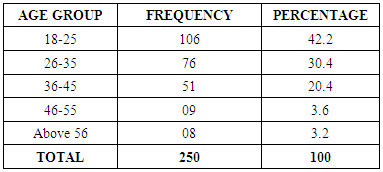 |
| |
|
Table 1 above shows that out of 250 respondents, majority i.e. 106 (42.2%) were between the age of 18 and 25 years, while 76 (30.4%) respondents were within 26 to 35 years of age. About 51 (20.4%) respondents were in between 36 to 45 years of age following 09 (3.6%) respondents were of 46 to 55 years of age. Only (3.2%) 08 respondents were of and more than the age of 56 years. The results demonstrate the descending use of public library with respect to age.Table 2. Level of Education of respondents
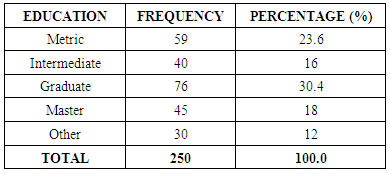 |
| |
|
Table 2 shows that the rate of usage of library according to the qualification of users, where the highest use of library by 76 respondents (30.4%) is done by graduate students. The respondents with Matriculation were 59(23.6) following the Masters who were 45 respondents (18%). Respondents with Intermediate education were about 40 (16%) while respondents with other qualifications making the total of 30 (12%). It shows the least use of users with intermediate and other qualifications may because they have facility of academic library at their academic institutions.Table 3. Distribution of Professional Status
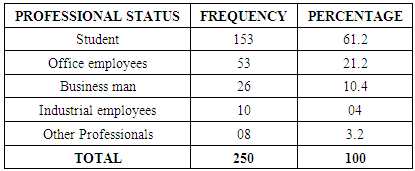 |
| |
|
Table 3 represents the using frequency of library with respect to user’s profession. It is clear from the table that maximum usage of library is done by the students while the ratio decreases in Office employees. The business man and Industrial employees were also present but in low amount. Also other professions were present in small amount.Table 4. Purpose of User’s visiting the library
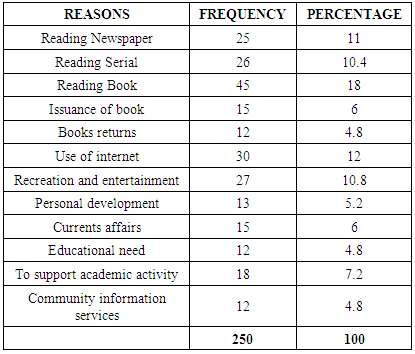 |
| |
|
Table 4 represents the purpose of user for visiting the library where it is understandable from the table that the users are visiting the library for a number of purposes. The ratios of their purpose varies time by time with respect to their other involvements such as the ratio of issuance increases before examinations while after exams the ratio of using recreational material increases.Table 5. Time of user spent in library
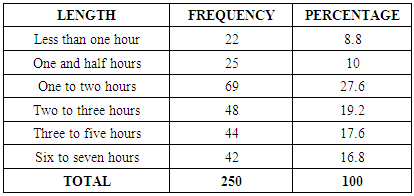 |
| |
|
Table 5 represents the time spent by users in the library where it can be significantly noticed by the table that most (27.6) of the users spend 1 to 2 hours in library while 19% of the users spend 2 to 4 hours in library. This ratio of users gradually decreases where 17.6% users spend 3 to 5 hours and 16.8 spend 6 to 7 hours of time. There are fewer amounts of users who spend 1 or less than 1 hour of time in library. This represents the majority of users spent more time in library activities.Table 6. Information needs and level of satisfaction of users
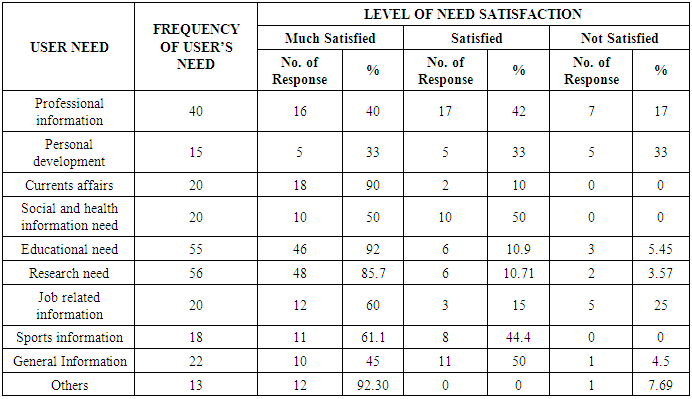 |
| |
|
Table 6 shows the potential information needs of the users. Among 250 respondents there were many users with multiple information needs where the maximum users are with research and educational needs. The professional information needs were than found among the users. Social health information needs, Sports information needs, general information needs and needs for current affairs were also present but at an average rate. The users with personal development information needs were in low amount. Table 7. Services provided by the library
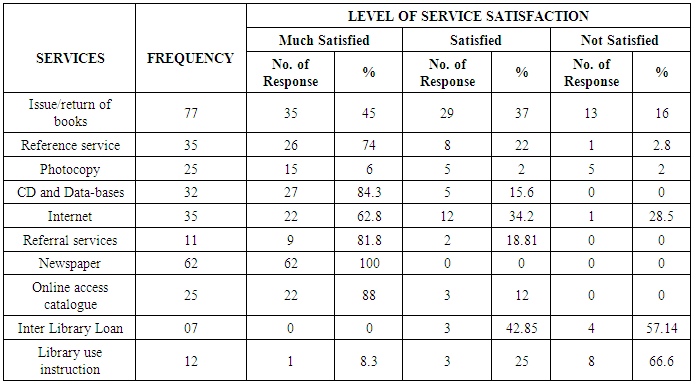 |
| |
|
Table 7 represents the services provided by the library and the level of satisfaction of users from these services. It shows that the maximum provided service was of Issue/Return and Newspaper with also high satisfaction response. Reference and Internet services are than provided and also carry good satisfaction of users. The rate of CD/ Database service is also provided following photocopying service and online access catalog. The low no of services provided were referral services, Inter library loan and Library use instructions but the overall rate of satisfaction was up to satisfactory.Table 8. Factors of User’s dissatisfaction
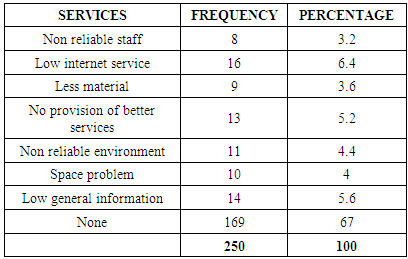 |
| |
|
Factor’s of User’s dissatisfaction was also determined and represented in Table 8 where high number of users have no reason of dissatisfaction represents the satisfaction level of users from the library. Few users were not satisfied from some factors as shown in the table.Table 9. Suggestion regarding improvement of library
 |
| |
|
10. Description
Some suggestions were also highlighted by the users where high number of users requires updated material in library. Lack of information provision on library instruction and use was also highlighted. Users also suggested for Flexible and long working hours of librarians as well as their cooperative attitude and supportive behavior.
11. Conclusions and Recommendations
From the respective study that was performed and analyzed, it was concluded that Liaquat memorial Library as a public library is accommodating number of tasks on daily basis. On studying user’s responses it was analyzed that majority of the user’s were student of Intermediate and of Master’s level using library services to fulfill their educational needs. Also there are users with multiple information needs to fulfill such as readings of recreational material as well as newspaper were also in high demand. Liaquat memorial library has also provided computer lab facility to its user’s with separate sections for male and female users. Also OPAC service is provided at the library and 88% of the users of OPAC were highly satisfied with the facility. Many users were satisfied with the Internet facility, Issue/Return service, reference and newspaper service, but not with the Inter-library loan service and guidance service.Overall, the rate of satisfaction of users was good but the factors of dissatisfaction were also present. Poor internet services at some time causing dissatisfaction for the users. Low cooperation from librarian and less guidance service were among unsatisfactory reasons.Users highly recommended for the change in attitude of librarians and suggested for more cooperative and supportive environment. On this observation it is suggested that libraries must pay attention towards skills and cooperativeness of employees while hiring. The librarians after appointing must continue to get refresher courses in order to update their intellectual level and must pay attention towards their attitude for users making it more helpful and obliging.It is also suggested for the library to make a community survey at regular interval to identify the changing needs of users and update their collection accordingly. Children literature and services for children must be incorporated for developing sense and usage for libraries in children’s mind. The suggestions are based on the study undertaken at Liaquat memorial library to enhance the quality of services and making user friendly atmosphere for the users of library.
References
| [1] | Hanif, Saima. (2013). Information resources, facilities and services in public libraries: A survey of the user’s satisfactionin Model Town Library, Lahore. PLA Journal. Retrieved January 2016, Available at: http://www.pla.org.pk/2013.pdf. |
| [2] | Prytherch, Ray. (2005). Harrod’s librarians glossary and reference book. (10th ed.). Ashgate e books. |
| [3] | Kinya, D. S. (2011). A case study of user’s survey in public libraries in Kenya. International research journal of library information and archival studies. 1 (13), 091-104. |
| [4] | IFLA/ UNESCO. (1994). Public library manifesto. Available at http:www.ifla.org/publications/iflaunesco-public-library-manifesto-1994. |
| [5] | Newke, M. C. (1995). Libraries and related activities as instrumentalities of education for rural development in Nigeria. Rural Libraries, 15(2), 45- 54. |
| [6] | Akinola, Olugbenga John. (2013). A survey of the services of public libraries in meeting the information needs of post secondary school students in some three selected public libraries in Nigeria, Greener journal of internet information communication system. 1(1), 1-12. |
| [7] | Ang C. (2001). The role of Public Libraries in the media society. Available at http://www.ns.nsb.norrkoping.se. |
| [8] | Sindh Archieves. (2014). Liaquat Memorial library. Retrieved Feb 20, 2017 from http://www.sindharchives.gov.pk/liaquat_library.aspx. |
| [9] | Issa, Abdul Wahab Olanrewaju, et al. (2011). Information needs of public library patron: A survey of user of Kwara state library Ilorin, Nigeria. PNLA quarterly. 75(3), 1-13. |
| [10] | Allen, T.J. (1969). Information needs and uses. Annual review of information science and technology, 4, 3-9. |
| [11] | Case, DO (2002). Looking for information: A survey of research in information seeking, needs, and behavior. Amsterdam: Academic Press. |
| [12] | Challener, J. (1999). Information seeking behaviour of professors of art history and studio art. Unpublished Master's Thesis, Kent State University. Devadason FJ & Lingman PP (1997). A methodology for the identification of information needs of users. IFLA Journal, 23 (1); 41-51. |
| [13] | Edem, US. & Bassey, BA. (1999). Information seeking behavior of graduate students in Nigerian universities. African Journal of Education and Information Management, 2(3): 160-125. |
| [14] | Feather, John and Strugges, Paul. (Eds.) (2003). International encyclopedia of Information and library science. London: Routledge. |
| [15] | International Federation of library association and organizations. (IFLA) (2001). The public library service: IFLA/UNESCO guidelines for development. Available at: http://www.ifla.org/VII/s8/proj/pub197.pdf. |
| [16] | Jam, Z. (1991-1992). The information needs of academic staff in non-university technologicallybased tertiary institutions in Benue State. , 25&26(1-4): 21-35. |
| [17] | Khan, Sadiq Ali. (1989). Public libraries and their services, Karachi. PLA Journal, 1-27. |
| [18] | Lguehi, Joy Ikenwe and Idowu, Adegbilero-Iwara. (2014). Utilization and user satisfaction of public library services in south west, Nigeria in the 21st century: Asurvey. International journal of library science. 3 (1), 1-6. |
| [19] | Nicholas, D. (2000). Assessing information needs: tools, techniques and concepts for the Internet age. (2nd ed). London: Aslib. |
| [20] | Omotosho, Abiola Modupeola. (2012). Challenges for public library patrons in the use of information services for attainment of health millennium development goals. Available at: http://unllib.unl.edu. |
| [21] | Tise, E. (2000). The role of libraries in socioeconomic development and the need for literacy. Meta-info Bulletin, 9(2): 55-61. |
| [22] | Zhang, W. (1998). Analyzing faculty and staff's information needs and use of electronic technologies: a liberal arts college's experience. Journal of Educational Media and Library Sciences, 35 (3): 218-241. |



 Abstract
Abstract Reference
Reference Full-Text PDF
Full-Text PDF Full-text HTML
Full-text HTML







